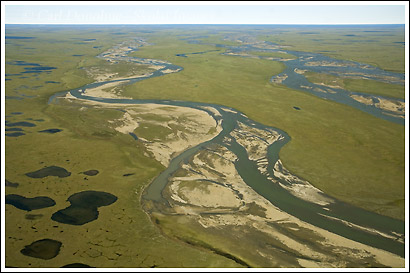Hey Folks,
Next I’m going to do a short series on the Arctic National Wildlife Refuge, known as ANWR, in Alaska. I’m sure most of the readers here are reasonably well versed in the situation in the Arctic National Wildlife Refuge, with the seemingly constant proposals to open the coastal plain to oil drilling. For those of you who aren’t familiar with it, a quick summary would go like this:
The Arctic National Wildlife Refuge sits in Alaska’s far northeast, extending from south of the Continental Divide in the Brooks Mountain Range, north over the Divide, stretching across the coastal plain to the Beaufort Sea and the Arctic Ocean.
The Arctic National Wildlife Refuge was designated a Wildlife Refuge in 1960, originally consisting of 8.9 million acres of land. The refuge boundary was expanded to it’s present 19 million acres in 1980, 8 million of which are designated Wilderness under the Wilderness Act of 1964.
A diverse and expansive ecosystem, the area has been home the Gwich’n Indian, who live on the south side of the Brooks range, and the Inupiat Indian, living on the north side along the coastal plain.
These people share the region with a diversity of wildlife: grizzly and polar bears live there, wolves, red and arctic foxes, muskox (reintroduced after being eradicated in 1860), caribou, wolverine, muskrat, moose, dall sheep, beaver, lynx and countless migratory birds, such as tundra swans, snowy owls, peregrine and gyrfalcon, golden eagles, and many more, all of whom rely on the lush coastal plain for their summertime foraging.
Protection of wildlife was named as one of the primary purposes in establishing the area as a refuge. Though the 1.5 million acre coastal plain was marked for potential oil and gas development, the Alaska National Interest Lands Conservation Act of 1980 prohibits this activity in the Arctic National Wildlife Refuge without Congressional approval.
A more recent report was updated in 2003. The proposal to open Section 1002, the coastal plain, to oil and gas development has been debated and proposed many times since 1987, and has been defeated each time, once by presidential veto in the Clinton administration in 1996.
I visited the Arctic National Wildlife Refuge in 2006, and spent nearly 2 weeks in the Refuge, hiking, paddling, photographing, and exploring the region. A friend and I travelled over 120 miles, from the Continental Divide, through the brooks range, out onto and across the coastal plain to the coast.
What became immediately apparent to us was the vastness of the place. It’s absolutely huge. Climbing to a high point in the Brooks Range, we could see endless peaks and mountains and valleys, ridgelines stretching endlessly in all directions. Out on the coastal plain one rolling hill bled into another, the arctic tundra simply losing the eye with it’s myriad infinite patterns.
The second thing that struck us both were the mosquitoes. Hundreds. Thousands. Lots of them. Lots and lots of them.
Big, hungry, persistent and unsympathetic to our plight, the mosquitoes of the arctic are impressive, though tough to deal with.
Hiking one afternoon out across the tundra we both ended up heading back to the relative safety of the gravelbars of the riverbed before we’d gone a mile or so. The mosquitoes can literally drive you crazy. Even wearing headnets and bug proof clothes, it’s possible to ignore them for only so long.
I try not to wear DEET (a pretty toxic bug repellent), but in a place like the Arctic National Wildlife Refuge, you can only hold out so long. Fortunately the bug season is, much like everything in this biosphere, intense but short.
Typically, late June the bugs are out, and by the end of July they’re numbers have faded to a more manageable population.
At their peak, in early-mid July, biologists’ studying the region conclude the biomass of the mosquito population in the Arctic National Wildlife Refuge is greater than that of the caribou population. USGS scientists estimate the caribou population for the area as being over 155 000 animals (approx 125 000 in the Porcupine caribou herd, and 30 000 in the Central Arctic herd).
I’ll try to write more in the coming days on the Arctic National Wildlife Refuge as I get time. I’m travelling, so it may take a litle while for my next update.
Cheers
Carl
More ANWR photos

A couple photographers I know are headed up to ANWR soon. I don’t know who they are traveling with – they are going primarily for birds. We hear so much about this place lately, it must have been terrific to experience it first hand.
Hey Mark,
I hope your friends have a good trip. There are some great spots up there for birds, so I’m sure they’ll get some great photos.
Visiting a place like this, especially for a couple of weeks or more, is an incredible experience. Trying to describe it is always going to be incomplete – you simply can’t reduce it to words.
Cheers
Carl
Carl,
What dates did you visit the Refuge?
Hey Jim
Thanks for the post. The first 2 weeks of July, 2006.
Thank you.
Cheers
Carl